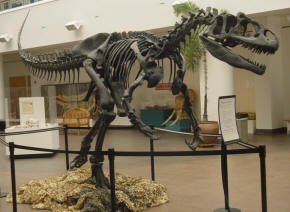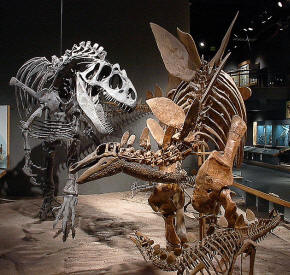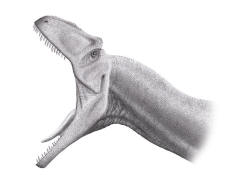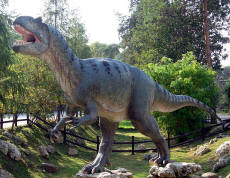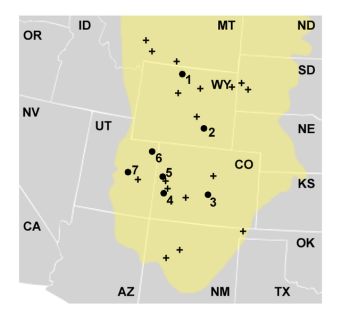 |
| Allosaurus Quarry Sites The
general extent of the Morrison Formation has been overlaid in
yellow. Historically or otherwise notable quarries where
Allosaurus remains
have been found include the numbered locations:
1) Big Al quarry, Big Horn Co., WY.
2) Como Bluff, Albany Co., WY.
3) Garden Park/Cañon City, Fremont Co., CO.
4) Dry Mesa Quarry, Delta Co., CO.
5) Grand Junction/Fruita, Mesa Co., CO.
6) Dinosaur National Monument West, Uintah Co., UT.
7) Cleveland-Lloyd Dinosaur Quarry, Emery Co., UT.
Other locations where
Allosaurus has
been found are marked with a "+".
|
Dinosaurs such as the theropods
Ceratosaurus,
Ornitholestes, and
Torvosaurus, the
sauropods
Apatosaurus,
Brachiosaurus,
Camarasaurus, and
Diplodocus, and the
ornithischians
Camptosaurus,
Dryosaurus, and
Stegosaurus are known from the Morrison.
The Late Jurassic formations of Portugal where Allosaurus is present
are interpreted as having been similar to the Morrison but with a stronger
marine
influence. Many of the dinosaurs of the Morrison Formation are the same
genera as those seen in Portuguese rocks (mainly
Allosaurus,
Ceratosaurus,
Torvosaurus, and
Apatosaurus), or have a
close counterpart (Brachiosaurus and
Lusotitan,
Camptosaurus and
Draconyx).
Allosaurus coexisted with fellow large theropods
Ceratosaurus
and Torvosaurus in both the United States and Portugal,
The three appear to have had different
ecological niches, based on anatomy and the location of fossils.
Ceratosaurs and torvosaurs may have preferred to be active around waterways,
and had lower, thinner bodies that would have given them an advantage in
forest and underbrush terrains, whereas allosaurs were more compact, with
longer legs, faster but less maneuverable, and seem to have preferred dry
floodplains. Ceratosaurus, better known than
Torvosaurus, differed
noticeably from Allosaurus in functional anatomy by having a taller,
narrower skull with large, broad teeth. Allosaurus was itself a potential food item to other carnivores, as
illustrated by an Allosaurus
pubic foot marked by the teeth of another theropod, probably
Ceratosaurus or
Torvosaurus. The location of the bone in the body
(along the bottom margin of the torso and partially shielded by the legs),
and the fact that it was among the most massive in the skeleton, indicates
that the Allosaurus was being scavenged.
Paleobiology
Life history
The wealth of
Allosaurus fossils, from nearly all ages of
individuals, allows scientists to study how the animal grew and how long its
lifespan may have been. Remains may reach as far back in the lifespan as
eggscrushed eggs from Colorado have been suggested as those of
Allosaurus.
Based on
histological analysis of limb bones, the upper age limit for
Allosaurus is estimated at 22 to 28 years, which is comparable to that
of other large theropods like Tyrannosaurus. From the same analysis, its maximum growth appears to
have been at age 15, with an estimated growth rate of about 150 kilograms
(330 lb)
per year.
Medullary bone tissue, also found in dinosaurs as diverse as
Tyrannosaurus and
Tenontosaurus, has been found in at least one
Allosaurus
specimen, a
shin
bone from the Cleveland-Lloyd Quarry. Today, this bone tissue is only
formed in female birds that are laying eggs, as it is used to supply
calcium
to shells. Its presence in the Allosaurus individual establishes sex
and shows she had reached reproductive age. By counting growth lines, it was
shown that she was 10 years old at death, so sexual maturity in
Allosaurus was attained well before maximum growth and size.
The discovery of a juvenile specimen with a nearly complete hindlimb
shows that the legs were relatively longer in juveniles, and the lower
segments of the leg (shin and foot) were relatively longer than the thigh.
These differences suggest that younger Allosaurus were faster and had
different hunting strategies than adults, perhaps chasing small prey as
juveniles, then becoming ambush hunters of large prey upon adulthood.
The thigh bone became thicker and wider during growth, and the cross-section
less circular, as muscle attachments shifted, muscles became shorter, and
the growth of the leg slowed. These changes imply that juvenile legs has
less predictable stresses compared with adults, which would have moved with
more regular forward progression.
Feeding
Paleontologists accept
Allosaurus as an active predator of large
animals.
Sauropods seem to be likely candidates as both live prey and as objects
of
scavenging, based on the presence of scrapings on sauropod bones fitting
allosaur teeth well and the presence of shed allosaur teeth with sauropod
bones.
There is dramatic evidence for allosaur attacks on
Stegosaurus,
including an Allosaurus tail vertebra with a partially healed
puncture wound that fits a Stegosaurus
tail
spike, and a Stegosaurus neck plate with a U-shaped wound that
correlates well with an Allosaurus snout.
However, as Gregory Paul noted in 1988, Allosaurus was probably not a
predator of fully grown sauropods, unless it hunted in packs, as it had a
modestly sized skull and relatively small teeth, and was greatly outweighed
by contemporaneous sauropods.
Another possibility is that it preferred to hunt juveniles instead of fully
grown adults.
Research in the 1990s and 2000s may have found other solutions to this
question.
Robert T. Bakker, comparing
Allosaurus to
Cenozoic sabre-toothed carnivorous mammals, found similar adaptations, such as a
reduction of jaw muscles and increase in neck muscles, and the ability to
open the jaws extremely wide. Although Allosaurus did not have sabre
teeth, Bakker suggested another mode of attack that would have used such
neck and jaw adaptations: the short teeth in effect became small serrations
on a saw-like
cutting edge running the length of the upper jaw, which would have been
driven into prey. This type of jaw would permit slashing attacks against
much larger prey, with the goal of weakening the victim.
Similar conclusions were drawn by another study using
finite element analysis on an Allosaurus skull. According to
their biomechanical analysis, the skull was very strong but had a relatively
small bite force. By using jaw muscles only, it could produce a bite force
of 805 to 2,148 N,
less than the values for
alligators (13,000 N),
lions
(4,167 N), and
leopards
(2,268 N), but the skull could withstand nearly 55,500 N of vertical force
against the tooth row. The authors suggested that
Allosaurus used its
skull like a hatchet against prey, attacking open-mouthed, slashing flesh
with its teeth, and tearing it away without splintering bones, unlike
Tyrannosaurus, which is thought to have been capable of damaging bones.
They also suggested that the architecture of the skull could have permitted
the use of different strategies against different prey; the skull was light
enough to allow attacks on smaller and more agile ornithopods, but strong
enough for high-impact ambush attacks against larger prey like stegosaurids
and sauropods.
Their interpretations were challenged by other researchers, who found no
modern analogues to a hatchet attack and considered it more likely that the
skull was strong to compensate for its open construction when absorbing the
stresses from struggling prey.
The original authors noted that Allosaurus itself has no modern
equivalent, that the tooth row is well-suited to such an attack, and that
articulations in the skull cited by their detractors as problematic actually
helped protect the
palate and
lessen stress.
Another possibility for handling large prey is that theropods like
Allosaurus were "flesh grazers" which could take bites of flesh out of
living sauropods that were sufficient to sustain the predator so it would
not have needed to expend the effort to kill the prey outright. This
strategy would also potentially have allowed the prey to recover and be fed
upon in a similar way later.
An additional suggestion notes that ornithopods were the most common
available dinosaurian prey, and that allosaurs may have subdued them by
using an attack similar to that of modern big cats: grasping the prey with
their forelimbs, and then making multiple bites on the throat to crush the
trachea.
This is compatible with other evidence that the forelimbs were strong and
capable of restraining prey.
Other aspects of feeding include the eyes, arms, and legs. The shape of
the skull of Allosaurus limited potential
binocular vision to 20° of width, slightly less than that of modern
crocodilians. As with crocodilians, this may have been enough to judge
prey distance and time attacks.
The similar wide field of view suggests that allosaurs, like modern
crocodilians, were ambush hunters.
The arms, compared with those of other theropods, were suited for both
grasping prey at a distance or clutching it close,
and the articulation of the claws suggests that they could have been used to
hook things.
Finally, the top speed of Allosaurus has been estimated at 30 to
55 kilometers per hour (19 to 34 miles per hour).
Social behavior
Allosaurus has long been regarded in the semitechnical and popular
literature as an animal that preyed on sauropods and other large dinosaurs
by hunting in groups.
Robert T. Bakker has extended social behavior to parental care, and has
interpreted shed allosaur teeth and chewed bones of large prey animals as
evidence that adult allosaurs brought food to
lairs for their
young to eat until they were grown, and prevented other carnivores from
scavenging on the food.
However, there is actually little evidence of gregarious behavior in
theropods,
and social interactions with members of the same species would have included
antagonistic encounters, as shown by injuries to gastralia
and bite wounds to skulls (the pathologic lower jaw named
Labrosaurus
ferox is one such possible example). Such head-biting may have been a
way to establish dominance in a
pack
or to settle
territorial disputes.
Although
Allosaurus may have hunted in packs,
it has recently been argued that Allosaurus and other theropods had
largely aggressive instead of cooperative interactions with other members of
their own species. The study in question noted that cooperative hunting of
prey much larger than an individual predator, as is commonly inferred for
theropod dinosaurs, is rare among
vertebrates in general, and modern
diapsid
carnivores (including lizards, crocodiles, and birds) very rarely cooperate
to hunt in such a way. Instead, they are typically territorial and will kill
and
cannibalize intruders of the same species, and will also do the same to
smaller individuals that attempt to eat before they do when aggregated at
feeding sites. According to this interpretation, the accumulation of remains
of multiple Allosaurus individuals at the same site, e.g. in the
Cleveland-Lloyd quarry, are not due to pack hunting, but to the fact that
Allosaurus individuals were drawn together to feed on other disabled or
dead allosaurs, and were sometimes killed in the process. This could explain
the high proportion of juvenile and subadult allosaurs present, as juveniles
and subadults are disproportionally killed at modern group feeding sites of
animals like
crocodiles and
komodo dragons. The same interpretation applies to Bakker's lair sites.
There is some evidence for cannibalism in Allosaurus, including
Allosaurus shed teeth found among rib fragments, possible tooth marks on
a shoulder
blade,
and cannibalized allosaur skeletons among the bones at Bakker's lair sites.
Brain and senses
The brain of
Allosaurus, as interpreted from spiral
CT scanning of an
endocast, was more consistent with
crocodilian brains than those of the other living
archosaurs, birds. The structure of the
vestibular apparatus indicates that the skull was held nearly
horizontal, as opposed to strongly tipped up or down. The structure of the
inner ear
was like that of a crocodilian, and so Allosaurus probably could have
heard lower frequencies best, and would have had trouble with subtle sounds.
The
olfactory bulbs were large and seem to have been well suited for
detecting odors, although the area for evaluating smells was relatively
small.
In popular culture
Along with
Tyrannosaurus,
Allosaurus has come to represent the
quintessential large, carnivorous dinosaur in popular culture. It is a
common dinosaur in museums, due in particular to the excavations at the
Cleveland Lloyd Dinosaur Quarry; by 1976, as a result of cooperative
operations, 38 museums in eight countries on three continents had
Cleveland-Lloyd allosaur material or casts. Allosaurus is the official
state fossil of Utah.
Allosaurus has been depicted in popular culture since the early
years of the 20th century. It is top predator in both
Arthur Conan Doyle's 1912 novel,
The Lost World, and its
1925 film adaptation, the first full-length motion picture to feature
dinosaurs.
It later became the starring dinosaur of the 1956 film
The Beast of Hollow Mountain,
and the 1969 film
The Valley of Gwangi, two
genre
combinations of living dinosaurs with
Westerns. In The Valley of Gwangi, Gwangi is billed as an
Allosaurus, although
Ray Harryhausen based his model for the creature on Charles R. Knight's
depiction of a Tyrannosaurus. Harryhausen sometimes confuses the two,
stating in a DVD interview "They're both meat eaters, they're both
tyrants... one was just a bit larger than the other."
Allosaurus also made appearances in the
Hammer 1966 remake
One Million Years B.C. and the 1975 film adaptation of
The Land that Time Forgot. In nonfictional presentations,
Allosaurus appears in the second and fifth episodes of the
BBC television
series
Walking with Dinosaurs,
Jurassic Fight Club, and the
Walking with Dinosaurs special
The Ballad of Big Al which chronicles the life of the
Allosaurus
specimen nicknamed "Big Al".
Return to the
Old Earth Ministries Online Dinosaur
Curriculum homepage.

Shopping
Many fine
reproductions of Allosaurus teeth, claws, skulls, and even complete
skeletons, are available from several companies. Please click the
links below to visit their websites.
Bay
State Replicas - Three skull varieties, complete hand, complete arm,
complete foot, complete leg, humerus, jaw w/teeth, foot claw, finger claw,
1st, 2nd, and 3rd digit fingers
Black
Hills Institute - Complete skeleton, skull with neck, leg, femur, skull,
reproduction head (fleshed), tooth (in matrix)
|
